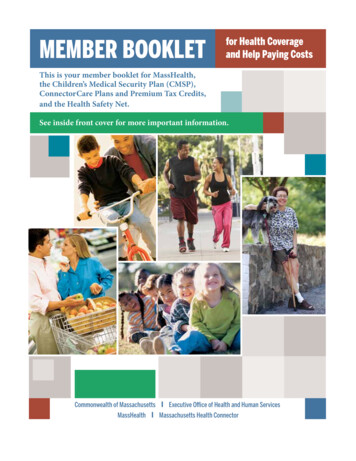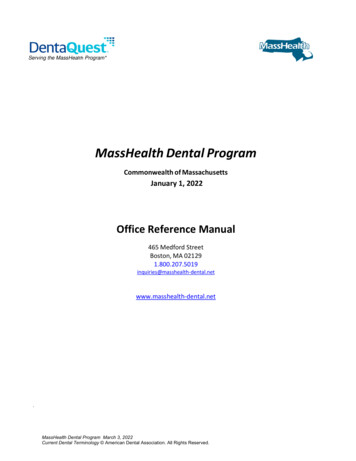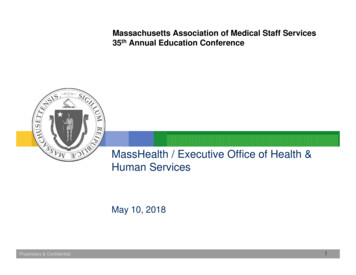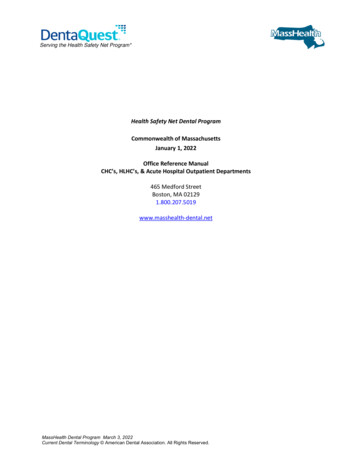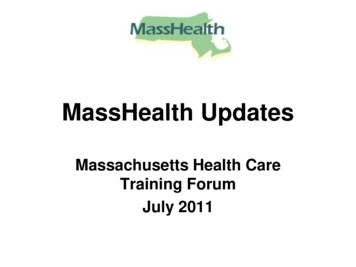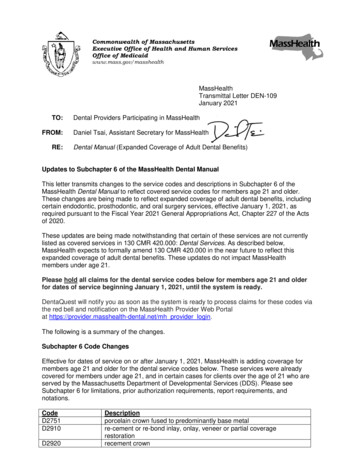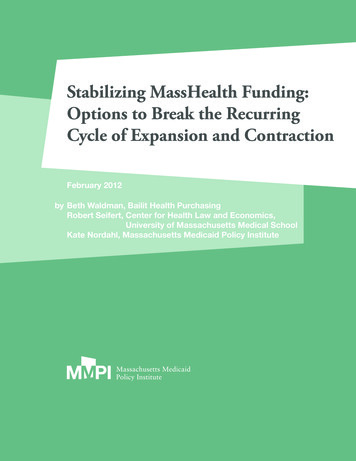
Transcription
Stabilizing MassHealth Funding:Options to Break the RecurringCycle of Expansion and ContractionFebruary 2012by Beth Waldman, Bailit Health PurchasingRobert Seifert, Center for Health Law and Economics,University of Massachusetts Medical SchoolKate Nordahl, Massachusetts Medicaid Policy Institute
AcknowledgmentsThe authors would like to thank the following people for their input and insight towardsthe development of this paper: Noah Berger, Bruce Bullen, Tom Dehner, Michael Miller,Sarah Nolan, Brian Rosman, Tricia Spellman, Jean Sullivan, and Nancy Turnbull.About the Massachusetts Medicaid Policy InstituteThe Massachusetts Medicaid Policy Institute (MMPI) — a program of the Blue Cross BlueShield of Massachusetts Foundation — is an independent and nonpartisan source of informationand analysis about the Massachusetts Medicaid program, “MassHealth.” MMPI’s mission is topromote the development of effective Medicaid policy solutions through research and policyanalysis.About the Center for Health Law and Economics,University of Massachusetts Medical SchoolThe University of Massachusetts Medical School’s Center for Health Law and Economics is asought-after partner among public agencies, non-profit organizations and foundations strivingfor health care system improvement and health policy analysis. CHLE’s collective expertise lies atthe intersection of health law and health policy, and includes health law and economics, policyimpact analysis, and structuring new policy, legal and financial frameworks.About Bailit Health PurchasingBailit Health Purchasing, LLC is a health care consulting firm dedicated to working with publicagencies and private purchasers to expand coverage and improve health care system performancefor consumers, purchasers and taxpayers.
Table of ContentsExecutive Summary. 11.Introduction. 62.Economic Cycles Affecting MassHealth Financing. 83.The Impact of Economic Cycles on MassHealth Program Policy. 174.Stabilizing Medicaid Going Forward. 245.Conclusion. 29
Executive SummaryMassHealth provides health care coverage to a significant portion of Massachusetts’ low-incomeresidents. Since eligibility depends on an individual’s income, demand for the program fluctuateswith economic activity in the state. When times are good and employment is high, the eligiblepopulation declines. When state economic growth slows and people lose their jobs (and theiremployer-based health insurance coverage), the low-income population needing health carecoverage from MassHealth grows. A major policy problem is that available funding for theprogram also depends on economic activity in the state as a whole. As the economy weakens,revenues available to cover the state share of the cost of MassHealth shrink, just as the need forcoverage increases.When this occurs, the Administration and the Legislature are forced to make difficult decisionsto keep program spending within the state’s means — decisions that are made more difficultbecause, being the state’s Medicaid program, MassHealth is an entitlement program with jointstate and federal funding. As such, it is required by federal law to cover certain populations andcertain services, regardless of state funding limitations.The imperative to cut when the economic downturn inevitably comes is further complicated bythe reverse phenomenon. As economic conditions improve, the need for MassHealth coveragedecreases, just as state revenues increase. When this has happened in the past, Massachusettshas not only reversed many of the cuts and program changes made in the previous downturn,but has also taken steps to expand MassHealth by raising the income-eligibility limit, coveringnew population groups, and expanding the services covered. All of this makes the inevitable cutsrequired during the next economic downturn even harder to achieve.The volatility resulting from this boom and bust cycling of the MassHealth program haswidespread negative impacts on the quality and continuity of care for MassHealth members andpotential applicants, for Medicaid providers and managed care organizations, and for staffing atthe Executive Office of Health and Human Services (EOHHS) and other state agencies involvedin the Massachusetts health care sector. While enrollment volatility is mostly among adults andfamilies — groups whose income eligibility is most sensitive to changing economic conditions —the cycle of programmatic cutbacks significantly affect seniors and people with disabilities becausethey remain eligible for many years and depend on the program to meet greater, more costlyhealth care needs. Year-to-year fluctuations in resources restrict MassHealth’s ability to effect longterm improvements in the effectiveness and efficiency of coverage for these groups of members.This year, once again, the state is struggling to balance its books with respect to MassHealth,with the need to cut 7 percent of total program spending in state fiscal year (FY) 2012 alone.1
This requires MassHealth to reduce spending by 770 million — an unprecedented amountfor the program to achieve within a single year. During the current economic downturn, thefederal government raised its matching rates1 for all states on the condition that no eligibility cutswould be made. Enhancing matching rates with these contingencies is indeed an effective federalapproach to stabilizing the continuity of Medicaid enrollments when state revenues plummet.The loss of this stabilizing funding in FY 2012 was, in fact, a major factor in explaining why theneed for spending reductions is so large this year.The options to cut MassHealth program spending in the short term are limited to those that canbe achieved within one state fiscal year, including: reducing eligibility by limiting populations the state has opted to make eligible to receiveMassHealth2 reducing the amount of time allowed for members to return annual eligibility redeterminationpaperwork, resulting in some MassHealth members having their coverage interrupted temporarily reducing benefits covered at state option (such as dental services) reducing provider payments (limited to federally permitted reimbursement rate freezes or cuts ) improving service utilization management (e.g., introduction of new prior authorization requirements)If MassHealth is unable to reach its targeted 770 million spending reduction, cuts may beneeded in other areas of the state budget as MassHealth spending crowds out other publicinvestments such as education, transportation, and infrastructure.MassHealth also has a longer-term focus on improving the program’s efficiency and the qualityof services its members receive. Initiatives aimed at these goals typically require a number ofyears to develop and implement, however. The long-term projects include care managementand integration programs (e.g., care coordination for PCC Plan members, the Patient CenteredMedical Home Initiative, integration of care and financing for dual eligible members), paymentreforms (e.g., reduced payment for preventable hospital readmissions, bundled paymentmethods), and other incentives to reduce service costs (e.g., policies and contracts that reduceuse of higher-cost sites and services in favor of lower-cost ones, funding primary care andcommunity-based supports to reduce the need for more costly medical care). These projectsrequire skilled and experienced staff resources and financial investments in the short term,1 Federal matching rates are formally referred to as Federal Medical Assistance Percentage (FMAP) rates.2 In recent years, Medicaid programs have been limited in their ability to modify eligibility for the program as enhanced federal fundinghas been conditioned on states’ maintaining the eligibility standards a state had in place as of July 2009.2
with better patient care and control of the program’s costs as an expected payoff in the future.MassHealth’s commitment to these initiatives acknowledges the importance of payment anddelivery system reform to the future stability of the program, but the agency staff’s ability to focuson these complex and longer-term projects is hampered by the need to solve immediate budgetissues, reprocure dozens of major provider contracts, and maintain operations for a program thatserves one in five residents of the state.This paper discusses options within state government control for reducing the reactive swings inMassHealth funding and scope of services that come with each economic downturn. Of course,Medicaid is not the only portion of the state budget that is strained during difficult economictimes. This paper advocates for the importance of a stabilizing mechanism specifically forMassHealth because of: its entitlement nature, which limits the state’s spending discretion; its size, accounting for about 30 cents of every state budget dollar; the concurrent loss of federal Medicaid revenue resulting from any cuts made to the program; the impact of cuts on the health care sector, an economic engine of the state’s economy; and the impact on a program that over 20 percent of state residents depend upon for their healthcare needs.A stabilizing mechanism would also benefit other health and human service agencies, hospitals,other health care providers, and businesses that may otherwise be called on to absorb some of theconsequences of decreasing Medicaid funds.The timing is propitious for opening such a discussion. Not only is there the potential of a periodof economic stability ahead, starting in 2014 there is also increased federal financing for Medicaidunder the federal health care reform law, the Affordable Care Act (ACA). Policymakers coulduse this opportunity to end the cycle of expanding and retracting MassHealth based on annualbudget fluctuations by developing a strategy to ensure the long-term stability of the program.Any mechanism to stabilize MassHealth funding should uphold, at a minimum, the followingcross-cutting principles to provide the greatest potential for success in meeting its ultimate goal.The mechanism should: improve MassHealth’s ability to conduct long-term planning, including improved forecasting,and implement comprehensive program improvements and reforms; include a well thought-out governance structure that provides oversight and assigns clear accountability for the implementation and use of the mechanism;3
be transparent, providing clear and understandable information on the mechanism and its allowable use; and apply lessons learned from past experience by Massachusetts and other states with similarmechanisms meant to stabilize spending or dedicate funds.We present three potential options for stabilizing mechanisms, which could be consideredseparately or in combination: Establish a Medicaid Stabilization Fund: This Fund could serve as a MassHealth- specific“rainy day fund.” A portion of additional federal money flowing to the state under the ACA,plus any appropriated but unexpended MassHealth dollars from a given fiscal year, could beretained in the Fund. In better economic times, a targeted amount could also be set aside anddeposited in the Fund. The Fund would only be accessible to the program under specified adverse economic circumstances. Thus, it would not be available to provide for additional benefitsor rate increases otherwise unaffordable in a fiscal year, absent a federally required mandate. Theuse of a Medicaid Stabilization Fund would be limited to costs related directly to caseload increasesand maintenance of effort relative to rates and benefits and, in limited circumstances, amounts maybe spent on up-front investments required to implement initiatives that can reduce the overall costs ofMassHealth or have been proven elsewhere to slow the rate of growth in Medicaid. In addition, during better economic times, a minimum contribution to the Medicaid stabilization fund shouldbe required before any eligibility or benefit expansions can be considered for the program. Adopt Multi-year Budgeting for MassHealth: MassHealth now makes its fiscal plans inan annual timeframe, making each year’s budget dependent on that year’s economic conditions and available revenues and limiting financial management options to only those thathave spending impacts in a matter of months. A multi-year budget is currently the practicein over 20 other states. Adopting this practice for just the MassHealth program could allowMassHealth time to invest in improvements and infrastructures that would ultimately havea bigger impact on containment of costs. Multi-year budgeting would provide MassHealth thenecessary time to plan and implement program improvements and reforms that produce much greaterreturns on investments relative to the quality and costs of MassHealth services, but necessarily takelonger to execute and require up-front investments.3 Create a Public Authority: Public authorities currently administer health coverage programsin Massachusetts, Maine, and Oklahoma. Converting administration of MassHealth from anexecutive branch agency to a public authority could allow more flexibility for longer-term financial arrangements and the program stability that comes with it. This stability, in turn, could3 Care must be taken, of course, not to project such planning too far into the future and to keep a sharp eye out for any shortfalls in thecost-savings projected for such innovations in health care organization and delivery.4
make possible more ambitious payment and delivery system reforms that, over time, couldimprove the management of the program and slow its cost trajectory.Some policymakers have argued for states to be given more latitude in managing their Medicaidprogram budgets through “block grants.” This option is not explored here, as it cannot beadopted by the state without federal intervention.44 While block grants would allow states to make changes to the program outside federal rules, block grants could also expose thestate to significant financial risk. As the state experiences economic downturns and the resulting increased need for Medicaidcoverage, it is unclear if the formula for annual increases in block grant allotments would be able to keep up with such need.For an in-depth analysis of the implications of block grant proposals on Massachusetts and other state Medicaid programs seehttp://www.kff.org/medicaid/upload/8173.pdf and http://www.kff.org/medicaid/upload/8185.pdf.5
1. IntroductionMassHealth provides health coverage to low-income Massachusetts residents. Given that theprogram’s eligibility is based on an individual’s economic situation, demand for the programincreases when the economy is in a downturn or recession. At those times, there is also increasedpressure on the program to reduce or constrain its spending based on the fiscal reality of thestate’s budget.MassHealth is the state’s Medicaid program. Medicaid is a state-administered health care programthat is jointly funded by the state and federal governments, with the proportion of federalfunding (the match rate)5 varying by state. The match rate for Massachusetts is about 50 percent.State participation in the program itself is voluntary, but once a state elects to operate a Medicaidprogram it must follow certain federal Medicaid program and financing rules. These includecoverage of mandatory populations and benefits and, for certain providers, mandated cost-basedreimbursement. Populations that MassHealth is required to cover under the federal Medicaidlaw, and the spending for mandatory services associated with those members, are consideredentitlements. As such, the state is required to provide Medicaid coverage to those populationsregardless of any economic or other state-specific considerations. Therefore, options to cutMassHealth spending are limited.In addition, the state’s own health reform law, which mandates coverage for individuals, andthe federal health care reform law, the Affordable Care Act (ACA), which extends the Medicaidentitlement beginning in 2014 to low-income adults without dependent children, further limitthe policy choices available to the state Administration and Legislature for reducing MassHealthspending. 6Medicaid is not the only portion of the state budget that is strained during difficult economictimes; other agencies within health and human services and across state government face manyof the same challenges that Medicaid does. Although the state’s “Rainy Day Fund” provides somecushion for the Commonwealth during such times, this paper advocates for the importance of anadditional mechanism to stabilize funding for MassHealth, specifically, because of: its entitlement nature, which limits the state’s spending discretion; its size: about 30 cents of every state budget dollar;5 The federal matching rate is formally known as the Federal Medical Assistance Percentage (FMAP) rate.6 The Government Accountability Office recently recommended that Congress consider enacting a formula that would automaticallyraise states’ federal match rates temporarily during national economic downturns. If enacted, such a formula would relieve some of thefinancial pressure resulting from Medicaid’s countercyclical nature. (Medicaid: Prototype Formula Would Provide Automatic, TargetedAssistance to State during Economic Downturns. GAO-12-38, November 2011.)6
the concurrent loss of federal Medicaid revenue resulting from any cuts made to the program;7 the impact of cuts on the health care sector, an economic engine of the state’s economy; and the impact on a program that over 20 percent of state residents depend on for their health careneeds.A mechanism to stabilize funding for the MassHealth program would also benefit other healthand human service agencies, hospitals, other health care providers, and businesses that mayotherwise be called on to absorb some of the consequences of decreasing Medicaid funds, forexample through increased demand for services or reduced payment rates.This brief describes the revenue cycles over the last thirteen years and their impact on theMassHealth program. It then opens a conversation to explore three potential options to breakthis cycle of expansion and contraction, and allow for more stable operation of the program: 1)a MassHealth Stabilization Fund, 2) multi-year budgeting for MassHealth, and 3) creation of apublic authority to administer MassHealth.7 Because MassHealth is jointly funded by the federal and state governments, any cut to a Medicaid reimbursed service only brings thestate 50 percent of the savings. In other words, for every 1 cut in the MassHealth program, the state realizes only 50 cents of savings andloses 50 cents of federal revenue.7
2. Economic Cycles Affecting MassHealth FinancingPublic demand for MassHealth is sensitive to economic cycles. When the economy lags andunemployment rises, people who lose their employer-sponsored health insurance may turnto MassHealth as an alternative. At the same time, fewer work hours or lower paying jobs forthose remaining employed means lower incomes, making some families financially eligible forMassHealth who were not eligible before. The following charts show the cyclical changes ineconomic conditions in Massachusetts and how those changes have affected the MassHealthprogram and the Commonwealth’s ability to support it.The official dates of the last two national recessions were March 2001 through November 2001and December 2007 through June 2009.8 As Figure 1 shows, unemployment in Massachusettsbegan to increase at the start of those economic slowdowns and continued to rise after thenational recessions had officially ended.Figure 1. Unemployment in Massachusetts# Unemployed% Unemployment Rate10%Local Peak350KJan 20108%280KLocal PeakJuly 2003140K4%70K199619971998199920002001RE C E SS ION6%RE C E SS dar YearSource: Bureau of Labor statistics (unemployment data); National Bureau of Economic Research (recession dates)Note: Natural population growth contributed minimally to the growth in the number of unemployed over this period. From 1997through 2009, the population in Massachusetts grew 8.5 percent, less than 1 percent per year.8 National Bureau of Economic Research.8
Growth in personal income is an indicator of the strength of the economy. Figure 2 shows thetrend in per capita personal income in Massachusetts. Personal income stagnated or fell duringand just after the two recent periods of recession, while unemployment increased, suggesting thatthe population with lower incomes — those most likely to qualify for MassHealth — also grew.As we shall see, during both periods MassHealth enrollment increased as state tax revenues fell.Figure 2. Massachusetts Personal Income Per Capita 60,000 50,000 40,000 30,000 10,0001996199719981999Source: Bureau of Economic Analysis20002001R ECESSIONR ECESSION 20,00020022003200420052006200720082009Calendar Year9
State revenues from taxes and assessments are the primary source of funding for the state’s shareof MassHealth spending.9 These revenues fell significantly during the economic downturns, when(as shown below) demand for safety net programs such as MassHealth increased.10 In the case ofthe 2001 recession, it took several years for tax revenues to regain their pre-recession level. Taxrevenues have still not recovered fully following the 2007-09 recession, as shown in Figure 3.Figure 3. State Tax and Assessment Revenues 25B 19.8 19.5 20B 18.6 15.8 16.2 15B 15.4 14.3 14.6 13.8 13.1 17.1 17.6 17.4 16.1 14.4 10B 5B 200920102011State Fiscal YearThe state fiscal year begins July 1 of the previous calendar year (e.g. SFY 2010 is from July 1, 2009 through June 30, 2010).Taxes include Income, Sales and Use, Corporate, Motor Fuel, and other taxes from a variety of goods and services including:alcoholic beverages (where applicable), certain banking transactions, cigarettes, income from estates, and hotel or roomoccupancy tax. Assessments are Ongoing charges to groups of customers of state services. Figure for SFY 2011 may not beexactly comparable to other years.Source: Comptroller of the Commonwealth (1997-2010); Department of Revenue, “June 2011 Tax Collection Summary(Preliminary as of July 19, 2011)” (2011).9 Federal reimbursement typically covers about half of state MassHealth expenditures. In the last two economic downturns, the federalgovernment has provided additional revenues to states to avoid drastic reductions to Medicaid through enhanced federal match for alimited time period. The latest provision of enhanced match ended on June 30, 2011.10 State tax policy also contributed to these trends. Several income tax rate cuts between 1997 and 2002 reduced revenue, as did an increasein the personal exemption and other changes from 2006 to 2008. In 2009, an increase in the sales tax and corporate tax changes mitigated the economy-related drop in revenue. (Source: Massachusetts Budget and Policy Center)10
Figure 4 summarizes the unemployment and revenue trends.11 In general, as unemployment rises,tax revenues fall, and vice-versa.Figure 4. Massachusetts Revenue and Unemployment TrendsTax Revenues# Unemployed1997 1998 1999 2000 2001 2002 2003 2004 2005 2006 2007 2008 2009 2010 2011State Fiscal YearSource: Comptroller of the Commonwealth (revenue trend); U.S. Bureau of Labor Statistics (unemployment trend).Research clearly confirms the positive relationship between unemployment and Medicaidenrollment.12 In Massachusetts, MassHealth enrollment accelerated during the recent recession, atthe same time that revenue to support the program was declining. Enrollment dynamics duringthe 2001 recession were less typical, possibly due in large part to policy changes that had theeffect of slowing enrollment or, in one case, eliminating coverage for a time for an entire categoryof MassHealth members.13 As Figures 5a and 5b show, MassHealth enrollment grew 15 percentfaster during the most recent period of rising unemployment than during the period of fallingunemployment that immediately preceded it. Most of the enrollment volatility is among childrenand families, or adults without dependent children — groups whose MassHealth eligibility ismore likely affected by the labor market and economic conditions generally. In contrast, theenrollment levels of persons with disabilities and those aged 65 and older remain relatively11 Figure 4 overlays the unemployment and revenue trends, without a scale, simply to show their interaction. The unemployment trendfrom Figure 1 has been plotted here on a state FY axis to match the tax revenue trend.12 For example, Ku, L. and Garrett, B. How Welfare Reform and Economic Factors Affected Medicaid Participation: 1984-96. Washington,DC: Urban Institute; 2000.13 Enhanced federal financial participation in the Medicaid program has occurred only during the two most recent financial crises. Toreceive the enhanced federal match, states needed to maintain eligibility rules during the recession. Because that was not the case in previous recessions, states did make changes to eligibility rules that masked growth in eligibility due to economic downturns.11
steady over time, keeping pace with demographic trends such as the aging of the baby boomerpopulation, but not fluctuating significantly with the economy (see Figure 6).Figure 5a. MassHealth 0Period ofdecreasingunemploymentPeriod ar YearSource: MassHealth. Monthly enrollment from 1997-2002 imputed based on actual enrollment in June of each year.12
Figure 5b. MassHealth Policy Changes Affecting Enrollment1,400,000Outreachcurtailed1,200,000July 2002MassHealthBasic curtailed,enrollment endsApril 20031,000,000July 2006October 2002800,000600,000Reduced timeallowed to returnrenewal formOctober 2003MassHealthEssential beginsChapter 58(Mass. reform law)expansionsJuly 1997MassHealth Waiver 032004200520062007200820092010Calendar YearSource: MassHealth. Monthly enrollment from 1997-2002 imputed based on actual enrollment in June of each year.Notes for Figure 5b: In July 2002, the state budget eliminated “mini-grants” for community organizations to conduct outreach andenrollment activities for people potentially eligible for MassHealth. In addition, MassHealth removed outreachstaff working in most sites. MassHealth redetermines the eligibility of most members at least once a year. If a member does not respond toa redetermination notice, the member is disenrolled from the program until eligibility can be re-established.In October 2002, MassHealth reduced the time allowed for responding to the notice from 60 days to 30. Inaddition, MassHealth stopped including a return envelope with the notice and discontinued sending a remindernotice. MassHealth Basic is an optional MassHealth program for long-term unemployed individuals with family incomebelow the federal poverty level. In April 2003, enrollment in MassHealth Basic was closed and eligibility eliminated for about 40,000 of its members. MassHealth Essential began in October 2003, covering many of those who lost eligibility for MassHealth Basicbut offering a slightly narrower benefit package.13
Figure 6. Fluctuations in MassHealth enrollment, adults and families vs. seniors and people with disabilitiesMonthly Change in Enrollment30,000Adults & FamiliesSeniors & dar YearSource: MassHealth enrollment snapshot data.Increasing demand for MassHealth services and anemic tax revenues, both largely the result ofeconomic conditions in the state, have led to increased budget pressures as MassHealth spendinghas grown. Federal Medicaid rules, combined with the state’s focus on insuring all of its citizens,limit policy choices that can be made in both stable and unstable economic climates, leading toMassHealth’s continued growth in real dollars and the charge that it is a “budget buster.” Figure7 shows MassHealth as a portion of the total annual state budget from state fiscal years 2005through 2010. (The chart shows gross MassHealth spending, which includes the federal revenuethe Commonwealth receives to support the program — about half the total MassHealth budget.)The impact is magnified during recessions, often leading to the need to make significant cutselsewhere in the state budget, particularly other health and human services agencies.14
Figure 7. MassHealth as a portion of all state spending (in billions) 35BOther State SpendingMassHealth 30B 27.8B 29.6B 28.9B 27.4B 25.4B 25B 23.5B 20B 15B 20.8B 20.9B 21.2B 19.3B 18.6B 17.2B 10B 5B 6.3B(27%) 6.8B(27%) 7.0B(25%)200520062007 7.7B(27%) 8.1B(29%)20082009 8.8B(30%) 0B2010State Fiscal YearSources: EOHHS (MassHealth data); Office of the Comptroller, Statutory Basis Financial Reports (other state spending).Note: The federal government reimburses Massachusetts for more than half of its spending on MassHealth, so the state’s netspending on MassHealth is less than half of the totals shown.While there is some flexibility to reduce Medicaid spending, Medicaid’s entitlement status limitshow much cost savings can com
MassHealth provides health care coverage to a significant portion of Massachusetts’ low-income . potential applicants, for Medicaid providers and managed care organizations, and for s

